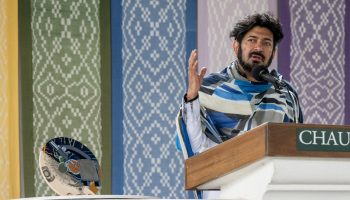The Four Seasons of Buenos Aires (Cuatro Estaciones Porteñas)
Ástor Piazzolla/Leonid Desyatnikov
The Argentinian composer Ástor Piazzolla was born on March 11, 1921, in Mar del Plata and died on July 4, 1992, in Buenos Aires. He was a noted bandleader and performer on the bandoneón, a square-shaped, button-operated accordion associated with folk idioms of Argentina, especially the tango. Piazzolla, more than any other composer and performer, was responsible for international interest in the tango as a dance and art form. He is credited with creating his own distinctive kind of tango, known as “nuevo tango,” a style that fused the traditional dance with modern compositional techniques, including jazz. His Four Seasons of Buenos Aires were composed in 1965 and 1970 for a quintet of instruments led by the bandoneón. The works were later arranged and transcribed for solo violin and string orchestra by the Kharkiv-born and Leningrad-trained composer, Leonid Desyatnikov (born 1955).
Los porteños (“the people of the port”) is a name associated with the working class society of Buenos Aires. It is this stratum of Argentinian society from which Piazzolla and his “new tango” arises. In 1965, the composer wrote music for a play by Alberto Rodriguez Muñoz titled Melenita de Oro, using the instrumentation of his Quinteto Nuevo Tango, which included bandoneón, violin, electric guitar, piano and string bass. Among the music for this play was a piece called “Verano Porteño,” which represented summer in Buenos Aires. Later, in 1970, Piazzolla decided to write pieces to represent the other seasons.
Most audiences, when thinking of music associated with the seasons of the year, immediately evoke the ever-popular set of four concertos for violin (“The Four Seasons”) composed circa 1721 by the Venetian master, Antonio Vivaldi. Unlike Vivaldi, Piazzolla’s original intention, as can be seen, was not to write a coherent set of pieces. Indeed, the works had nothing whatsoever to do with Vivaldi until the Russian composer Leonid Desyatnikov made an arrangement of the four works, for solo violin and strings that inserted clever references to Vivaldi’s more famous works. Interestingly, Desyatnikov went on to compose his own “Russian Seasons” for violin, solo voice and string orchestra.
The resulting work by Piazzolla and Desyatnikov, with its Argentinian pop idiom blended with the Baroque, offers a refreshingly “new” take on the idea of giving the seasons of the year a musical representation. But audiences should remember that the seasons in the southern hemisphere are the opposite of those above the equator. Don’t be too surprised, then, to hear references to Vivaldi’s “Winter” (L’inverno) in the midst of Piazzolla’s “Summer” (Porteño Verano).
Symphony No. 5, op. 47
Dmitri Shostakovich
Dmitri Dmitriyevich Shostakovich was born in Saint Petersburg on Sept. 12, 1906. He died in Moscow on Aug. 9, 1975. He was one of the Soviet Union’s greatest composers. Although he composed in a wide variety of genres, including film scores, he is best known for his 15 symphonies, which are among the finest examples of its kind from the mid-20th-century. His Fifth Symphony was first performed in Leningrad (now, once again, St. Petersburg) on Nov. 21, 1937. Its success was unequivocal and it remains one of the landmark compositions of this century. It is scored for two flutes, piccolo, two oboes, two clarinets, E-flat clarinet, two bassoons, contrabassoon, four horns, three trumpets, three trombones, tuba, timpani, percussion (triangle, snare drum, cymbals, bass drum, tam-tam, bells, xylophone), two harps, piano, celesta and strings. The work was last performed by the Winston-Salem Symphony in November 2004 under the baton of Maestro Peter Perret.
It is an ironic commentary on history when one cannot unequivocally state that a piece of music is its composer’s most popular one. The judgment, on face value, is innocent enough. Shostakovich’s Fifth Symphony is his best known and most frequently performed work. A pejorative overtone creeps in, however, when one tries to define the word “popular” by seeking its opposite, such as when “popular” music (i.e., rock, hip-hop, or traditional) is contrasted with “art” music (symphonies, chamber music, opera). How many of us, for example, have at some time or other characterized some “popular” music as “coarse, primitive, (or) vulgar”? These, however, are the precise words that appeared in a January 1936 article in Pravda titled “Muddle Instead of Music,” an article (possibly authored by Joseph Stalin himself) that denounced Shostakovich’s opera, Lady Macbeth of the Mtsensk District and ballet, “The Limpid Stream.” Thus began one of the saddest episodes in 20th-century music history — the official exile of one of the Soviet Union’s most gifted talents. Those who dared to stand by Shostakovich, either personally or artistically, did so at grave risk to their own career — or even life.
The irony, however, was yet to come. Shostakovich sought to deal with Stalin’s rebuke through continued work on new compositions. His immense fourth symphony was written over the course of the subsequent months of 1936, but the work was withdrawn under suspicious circumstances shortly before its scheduled premiere in April. The Fifth Symphony, composed during the next year, enjoyed a much happier fate. One journalist dubbed the new symphony as “a Soviet artist’s practical, creative reply to just criticism,” a subtitle that was used for the first time at the Moscow premiere in 1938. Shostakovich, typically, neither endorsed nor renounced the title.
But did the Fifth Symphony truly represent the rehabilitative effort from a man who had fallen from the good graces of a repressive regime? Evidence that has recently surfaced in two books — Solomon Volkov’s Testimony: The Memoirs of Dmitri Shostakovich (London, 1979) and Elizabeth Wilson’s Shostakovich: A Life Remembered (Princeton, 1994) — paints a rather different portrait. Here we discover a composer who at first believed his career lay in ruins. His strategy became the maintenance in public of humility and submission. In private, by contrast, Shostakovich set himself on a course of defiant resistance to Stalinist repression by encoding private warnings and references into his scores. Purely instrumental music, after all, has one advantage over works for the stage; censors, who for the most part are musical illiterates, have a harder time applying their political standards. One may recall here how, 100 years earlier, the crafty Robert Schumann had slipped the forbidden “Marseilles” past the Viennese censors in his Faschingsschwank aus Wien.
Shostakovich’s Fifth Symphony owes, as is the case with much of his other music, a debt of gratitude to the color and sardonic wit found in the music of Gustav Mahler. The powerful opening Moderato begins with a jagged figure treated imitatively in the strings. This paves the way for music of a haunting lyricism. After the first climax, a broad song emerges over a throbbing accompanying figure in dactyls. The gentle pulsation turns outright threatening with the introduction of the percussive sound of the piano and a quickening of speed. The music becomes increasingly frenetic, reaching shattering climaxes before returning to its majestic opening speed and demeanor. It ends shrouded in mystery as the celesta plays its haunting chromatic scales.
The second movement, Allegretto, is a saucy scherzo that dresses itself as a kind of sardonic waltz. Its cheeky character is highlighted by the color of the soprano clarinet and solo violin. The high spirit of this movement yields to the dramatic poignancy of the ensuing Largo. This movement begins soulfully in the divided strings. The highest violins soon introduce a new theme based upon a repeated-note figure. An ethereal duet for flutes over an undulating harp ostinato accompaniment follows. Later, the solo oboe introduces yet another haunting tune. A climax of terrific intensity is achieved based upon the high violin theme, but the tension finally breaks. The movement ends with the oboe theme, now played by celesta and harp (in bell-like harmonics), melting into a more optimistic major chord in the hushed strings.
The finale, Allegro non troppo, is famous for its rousing opening theme, played by trumpets, trombones and tuba over the pounding kettledrums. This theme may have pleased Shostakovich’s socialist-realist critics, but they would have been less enthusiastic if they knew that its opening notes were derived from the first song, “Rebirth,” from the composer’s Four Pushkin Romances. Even more telling is the later theme in the movement bearing material that Shostakovich had set to the following words: “Thus delusions fall off/ My tormented soul/ And it reveals to me visions/ Of my former pure days.” A tumult of new themes follows, some of which are evocative of themes heard earlier in the symphony. A slowly oscillating ostinato in the violins takes over, leading to one of the real strokes of genius in the movement — the slow, soft reintroduction of the opening martial theme. The movement ends in a dignified blaze of glory as this theme arrives at its apotheosis in the resplendent brass. Perhaps this is what Shostakovich had in mind when he spoke of his Fifth Symphony as “the stabilization of a personality.” Few works can match these concluding pages for depicting the sheer triumph of the human spirit over adversity.
David B. Levy is professor of music at Wake Forest University in Winston-Salem, North Carolina. He will present a pre-concert lecture on Thursday’s program at 6:45 p.m. in the Hurlbut Church sanctuary.





